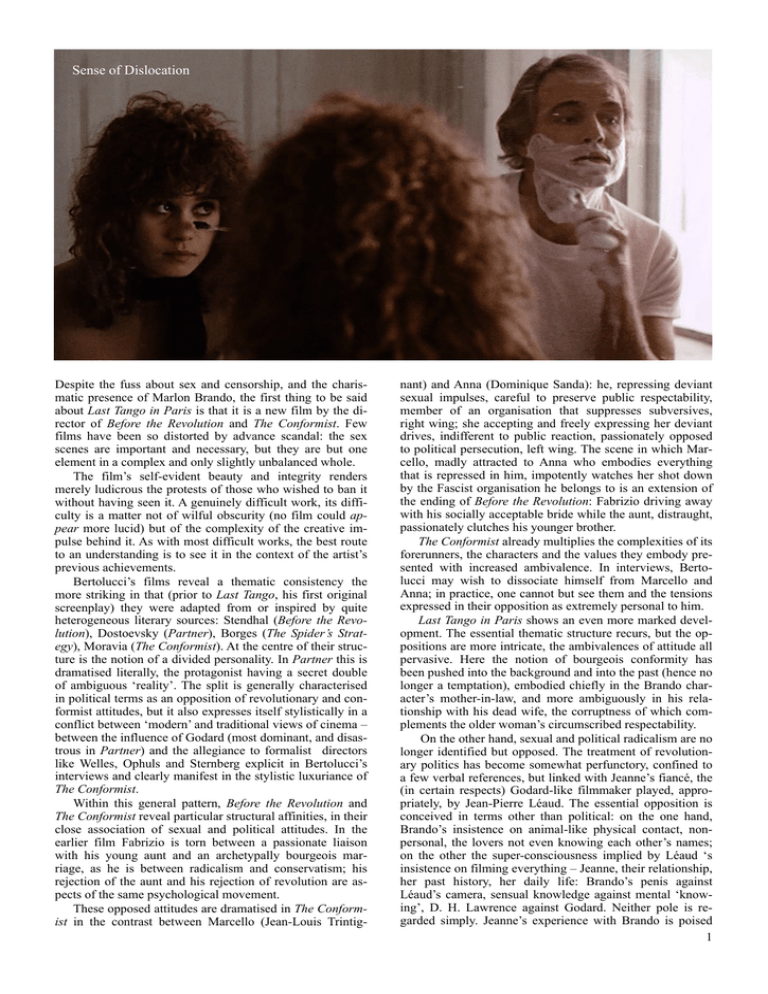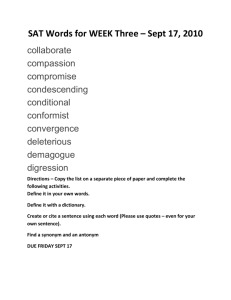
Sense of Dislocation
Despite the fuss about sex and censorship, and the charismatic presence of Marlon Brando, the first thing to be said
about Last Tango in Paris is that it is a new film by the director of Before the Revolution and The Conformist. Few
films have been so distorted by advance scandal: the sex
scenes are important and necessary, but they are but one
element in a complex and only slightly unbalanced whole.
The film’s self-evident beauty and integrity renders
merely ludicrous the protests of those who wished to ban it
without having seen it. A genuinely difficult work, its difficulty is a matter not of wilful obscurity (no film could appear more lucid) but of the complexity of the creative impulse behind it. As with most difficult works, the best route
to an understanding is to see it in the context of the artist’s
previous achievements.
Bertolucci’s films reveal a thematic consistency the
more striking in that (prior to Last Tango, his first original
screenplay) they were adapted from or inspired by quite
heterogeneous literary sources: Stendhal (Before the Revolution), Dostoevsky (Partner), Borges (The Spider’s Strategy), Moravia (The Conformist). At the centre of their structure is the notion of a divided personality. In Partner this is
dramatised literally, the protagonist having a secret double
of ambiguous ‘reality’. The split is generally characterised
in political terms as an opposition of revolutionary and conformist attitudes, but it also expresses itself stylistically in a
conflict between ‘modern’ and traditional views of cinema –
between the influence of Godard (most dominant, and disastrous in Partner) and the allegiance to formalist directors
like Welles, Ophuls and Sternberg explicit in Bertolucci’s
interviews and clearly manifest in the stylistic luxuriance of
The Conformist.
Within this general pattern, Before the Revolution and
The Conformist reveal particular structural affinities, in their
close association of sexual and political attitudes. In the
earlier film Fabrizio is torn between a passionate liaison
with his young aunt and an archetypally bourgeois marriage, as he is between radicalism and conservatism; his
rejection of the aunt and his rejection of revolution are aspects of the same psychological movement.
These opposed attitudes are dramatised in The Conformist in the contrast between Marcello (Jean-Louis Trintig-
nant) and Anna (Dominique Sanda): he, repressing deviant
sexual impulses, careful to preserve public respectability,
member of an organisation that suppresses subversives,
right wing; she accepting and freely expressing her deviant
drives, indifferent to public reaction, passionately opposed
to political persecution, left wing. The scene in which Marcello, madly attracted to Anna who embodies everything
that is repressed in him, impotently watches her shot down
by the Fascist organisation he belongs to is an extension of
the ending of Before the Revolution: Fabrizio driving away
with his socially acceptable bride while the aunt, distraught,
passionately clutches his younger brother.
The Conformist already multiplies the complexities of its
forerunners, the characters and the values they embody presented with increased ambivalence. In interviews, Bertolucci may wish to dissociate himself from Marcello and
Anna; in practice, one cannot but see them and the tensions
expressed in their opposition as extremely personal to him.
Last Tango in Paris shows an even more marked development. The essential thematic structure recurs, but the oppositions are more intricate, the ambivalences of attitude all
pervasive. Here the notion of bourgeois conformity has
been pushed into the background and into the past (hence no
longer a temptation), embodied chiefly in the Brando character’s mother-in-law, and more ambiguously in his relationship with his dead wife, the corruptness of which complements the older woman’s circumscribed respectability.
On the other hand, sexual and political radicalism are no
longer identified but opposed. The treatment of revolutionary politics has become somewhat perfunctory, confined to
a few verbal references, but linked with Jeanne’s fiancé, the
(in certain respects) Godard-like filmmaker played, appropriately, by Jean-Pierre Léaud. The essential opposition is
conceived in terms other than political: on the one hand,
Brando’s insistence on animal-like physical contact, nonpersonal, the lovers not even knowing each other’s names;
on the other the super-consciousness implied by Léaud ‘s
insistence on filming everything – Jeanne, their relationship,
her past history, her daily life: Brando’s penis against
Léaud’s camera, sensual knowledge against mental ‘knowing’, D. H. Lawrence against Godard. Neither pole is regarded simply. Jeanne’s experience with Brando is poised
1
between liberation and degradation: it is perhaps related to
the ambiguous release the male prostitute offered Marcello
at the end of The Conformist. Against it, the Léaud scenes
are airily exuberant, yet in the strict sense superficial, never
penetrating the surfaces of experience his camera photographs.
The sense of dislocation is at the centre of Bertolucci’s
work, the Francis Bacon paintings of male and female that
back the credit-titles constituting an explicit acknowledgment of this. None of the characters of Last Tango is whole;
in a sense, all are Bertolucci, but the balance striven for
(though disturbed by Brando’s penchant for extended improvisation) results in a more successful distancing than was
achieved in The Conformist. The flamboyant rhetorical gestures of that film, creating effects in excess of any communicated meaning, are absent from Last Tango, the beauty
and complexity of which are enhanced by the new stylistic
rigour. The fact that the division of attitude is located primarily in Jeanne (Maria Schneider) – the first time a woman
has been structurally central to a Bertolucci film – may also
contribute to this distancing.
How completely successful is the film? I don’t know
yet. I do know that I shall return to it again and again; that it
extends and deepens Bertolucci’s exploration of disjunction;
that the last 20 minutes (from Jeanne’s return to the empty
flat) offer one of the most moving experiences in modern
cinema; that the total effect is as liberating as it is disturbing; that, for all its apparent pessimism, I came out feeling
happy and strengthened, and feeling for Bertolucci not just
admiration but a deep affection.
Robin Wood
Times Educational Supplement, 23rd March 1973.
©Estate of Robin Wood
Movie: A Journal of Film Criticism, 2, 2011.
2





